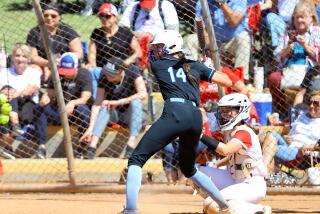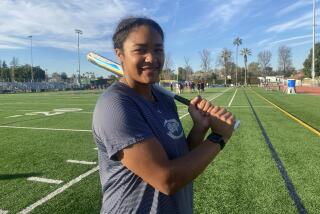Prep Wednesday : They’re Paying Price of Staying Home With Assortment of Injuries
- Share via
Talk with the county’s top high school softball catchers and they will disclose myriad bruises, aches and gouges and sprained and jammed fingers.
Western catcher Lisa Sciarrino has constant pain and swelling in her knees.
Kennedy’s Kris Vucurevic, a four-year varsity starter who is headed for the University of Nebraska next season, has had surgery on her hand to alleviate pain and swelling.
Shannon Dolan of Fountain Valley has a left knee that is “always sore and stiff” and cracks all the time.
Chanele Chambrone, a senior at Canyon who will play for Cal State Long Beach next season, suffered a bruise when she caught a bat in the back of the head in her Bobby Sox days, and Erin McKenney, a four-year varsity player at catcher and outfield for Sunny Hills, missed two games last season with a sore knee suffered in a collision.
Though they have all suffered a variety of aches and pains, most have one thing in common--pain in their knees.
“Actually, that squatting position is a bad position for the knee,” said Dr. Pablo Prietto, an orthopedic surgeon in Orange who works with UC Irvine, Rancho Santiago College and several county high schools.
Ken Yoshino, a certified athletic trainer and physical therapist and director of the Athletic Conditioning and Injury Center in Irvine agrees: “When catchers get down into that deep squat, that markedly increases the pressure inside the knee.”
It puts an unusually large strain on the sliding surfaces of the knee and on the ligaments--the straps inside the knee that keep the bones from moving out of their normal motions, he said.
The problem is compounded for women.
“Those catchers, because they are women, are predisposed to patella or kneecap problems,” Yoshino said. “This is because of the way a woman is built. They are designed to have children; therefore, their hips are a little wider and that changes the pull of the muscle to the kneecap.”
Because of that, the kneecap will often have problems sliding properly, he said.
Also a catcher is most likely to sustain knee problems as the result of a collision.
These factors, coupled with the constant squatting and up-and-down motions required in catching, may cause irritations in the knee such as a degeneration of the sliding surfaces, and an inflammation of the knee lining that can cause swelling, pain and crepitation or grinding.
Does this mean catchers are doomed to an old age of painful arthritic knees?
Prietto says no.
“Theoretically, catching is a bad postion for the knees, but we don’t really see an epidemic of knee problems,” he said. In fact, he says problems such as tennis elbow, tennis toe and skier’s thumb are more prevalent.
The reason is natural selection, said Dr. Robert Bielen, an orthopedic surgeon in Irvine who works with the U.S. men’s national water polo team as well as with athletes at Orange Coast and Southern California colleges.
“Go back to the teen-age years, and if a player is experiencing knee problems, then they generally can’t perform as well at that position and generally get selected out,” Bielen said.
Players can minimize knee stress and aching by keeping their legs, especially the quadriceps muscle above the knee, in condition year-round, not just during the season, Bielen said.
Yoshino, who is hurdler Edwin Moses’ physical therapist, recommends weight lifting and altering the traditional catching stance so one leg is extended to the side a bit.
“If they don’t take care of themselves, they can have problems later on down the road,” Yoshino warned. “I think they should cross train--do other activities to give their knees a break. Swimming and biking are excellent.”
More to Read
Go beyond the scoreboard
Get the latest on L.A.'s teams in the daily Sports Report newsletter.
You may occasionally receive promotional content from the Los Angeles Times.










